Sharp LC-46LE831E Review
Sharp LC-46LE831E
After mostly impressing us with its 3D debut a few months back, the 60in 60LE925E, Sharp has finally followed it up with the more manageable - and vastly more affordable - 46in 46LE831E.
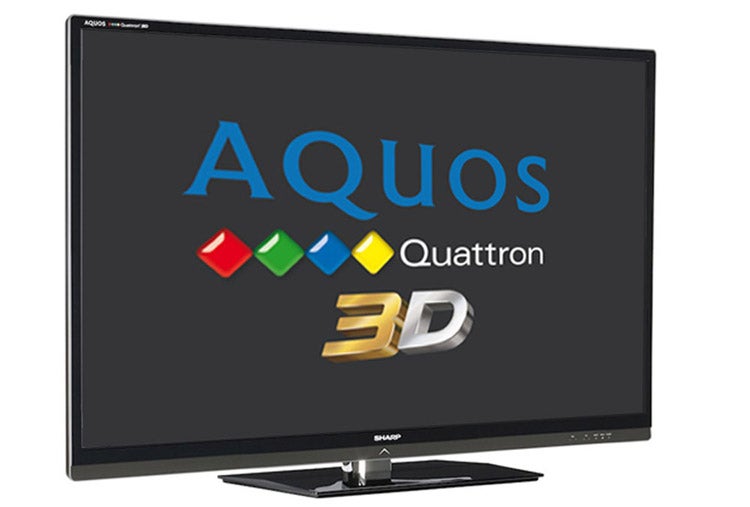
Verdict
Pros
- Startlingly good 3D pictures
- Very good 2D pictures too
- Good value
Cons
- Slightly clumsy OS
- Online features off the pace
- Yellows occasionally look slightly over-aggressive
Key Specifications
- Review Price: £1119.99
- 46in 3D TV with edge LED backlight
- Sharp’s proprietary Quattron technology
- AQUOS Net+ online features inc Skype
- Wi-fi dongle included
- USB Time Shift function
Sharp is not, it would seem, a brand to be rushed when it comes to 3D. For having debuted its first ever 3D TV in October 2010, the impressive but flawed 60in LE-60LE925E, it’s only now that the brand has seen fit to follow that up with something more mass market.
That something is the LC-46LE831E: a more manageable 46in model we’ve found selling for the very reasonable price of £1,119.99 (though this doesn’t include any of Sharp’s AN-3DGD20-B 3D glasses as standard).
Making this price look all the more reasonable is the fact that the 46LE831E’s 3D talents are actually just part of its overall appeal. For starters, the edge LED set also boasts Sharp’s proprietary Quattron technology, which finds an extra yellow pigment being added to the red, green and blue ones used by every other LCD TV. The idea behind this is simple: the more colour components you make available to a TV for ‘mixing’ its picture’s colours, the more potentially accurate those pictures could look. Especially where yellows and golds are concerned.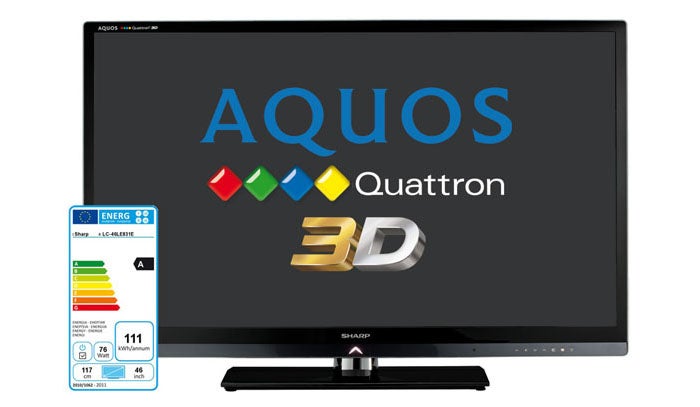
Sharp also argues that the relatively transmissive nature of yellow compared with the other heavier primary colours (red, green, cyan, magenta and blue) enables its Quattron panels to be more efficient, as they don’t need as much power to deliver bright pictures. So proud of this is Sharp that it includes the set’s official Energy rating chart – complete with an A grade, of course – alongside the photo of the TV on its website, as reproduced on this page.
Sharp has additionally ramped up its multimedia talents for the 46LE831E. The brand’s AQUOS Net online service now includes open Internet browsing and will also deliver Skype following a firmware update in July.
‘Ring-fenced’ services, meanwhile, include TomTom, eBay, myalbum.com, cinetrailer, Daily Motion, Box Office 365 (subscription), the Cartoon Network (subscription), iConcerts, YouTube and the FunSpot game channel.
While the AQUOS Net presentation is tidy enough, though, its services aren’t nearly as wide-ranging as those now sported by most of Sharp’s rivals. The BBC iPlayer is particularly sorely missed. As with all online TV services, though, there’s plenty of scope for things to improve in the coming months.
Accessing the 46LE831E’s online features can be done via Ethernet port or, rather pleasingly, wi-fi, via a provided USB dongle. This USB dongle will occupy one of three USB ports on the set, with the other two able to either play music, photo or video (including DivX-HD) files from USB storage devices, or else record to USB drives from the set’s Freeview HD tuner.
Other key connections including four HDMIs, an SD card slot, a D-Sub PC port, and an RS-232 port that allows you to make the TV part of a wider home control system. The set carries DLNA support, too, for accessing files on networked PCs.
Aesthetically the 46LE831E is a winner. Its black bezel is extremely slim and very elegant with its little metallic trim, and the split bottom edge with its angled bottom half looks divine – especially with the rather cool little illuminated Sharp ‘swish’ logo in its centre.
Heading into the 46LE831E’s onscreen menus turns out to be quite a daunting adventure – mostly because there’s so much to get your teeth into, but partly because the menus struggle to deal with everything in an efficient way.
The basic idea behind the menus is solid. Hit the menu button and the picture shrinks down to accommodate a cross-axis set of menus based around the top right corner of the screen.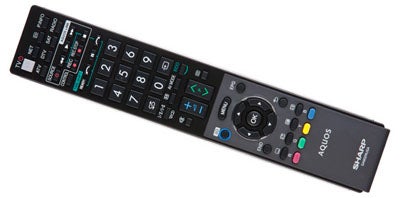
This means you can keep watching the picture while you make your adjustments. But it also means there isn’t as much space left as we’d like for the menu options, especially as they include such sophisticated fine-tuning tools as a colour management system (with hue, saturation and ‘value’ adjustments for the six primary colours), multiple settings for the TV’s scanning backlight, a gamma adjustment, and different levels of the set’s ‘Film Mode’ motion processing.
Both the Film Mode and Scanning backlight features need to be treated with great care, though, as they can make pictures look processed, artefact-heavy and generally unnatural if set to high. Actually, the Film Mode can cause flickering around moving objects even on its lowest-power setting during Blu-ray viewing.
Just as well, then, that unlike many previous Sharp TVs, the 46LE831E’s natural response time seems very good, meaning there’s precious little motion blur even with the motion processing options off.
The 46LE831E claims a 200Hz refresh rate thanks to the combination of the scanning backlight with native 100Hz processing. What’s more, the full HD panel is one of Sharp’s new X-Gen ones, which claims to boost contrast significantly by delivering more precise pixel control to reduce light leakage.
Popping on a pair of Sharp’s 3D glasses and settling down to watch the 46LE831E, two things became immediately apparent. First, the glasses are more comfortable than most, sitting comfortably on your nose and covering pretty much all of your field of vision. Second, 3D pictures look unexpectedly but gratifyingly brilliant.
The most strikingly obvious reason for this is the exceptionally small amount of crosstalk in the picture. Sharp’s press blurb on the 46LE831 suggests crosstalk has been reduced by at least 30% from the first 3D Quattron set, and from the puny amounts of ghosting we can see, this actually appears to be a conservative figure.
Crosstalk hasn’t been completely eliminated; it’s still vaguely evident on really tough sequences like the Tangled lantern or Golden Gate Bridge sequences in Monsters Vs Aliens. But you generally either won’t see it at all, or else it will appear more as a very subtle halo around an object rather than an obvious, distracting ‘ghost’.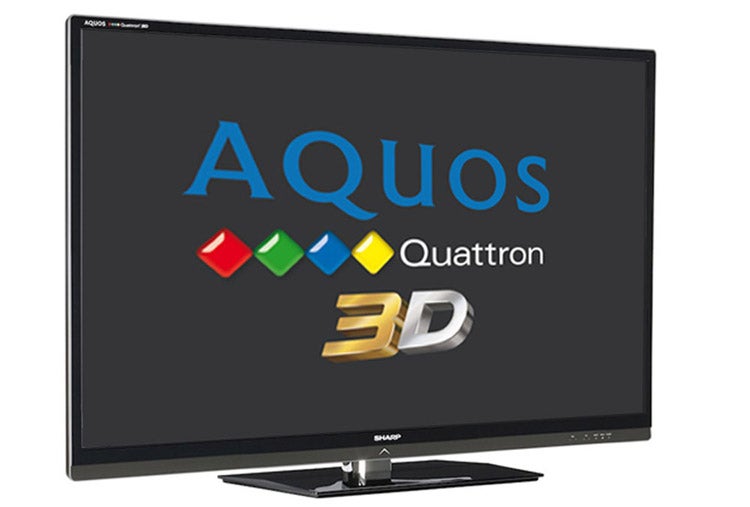
Not having to squint through crosstalk makes it easier to appreciate the 46LE831’s lovely knack of bringing out the full HD detail levels in 3D Blu-rays, and the way this sharpness remains largely intact when there’s motion going on within the 3D frame.
Also pretty stunning about the 46LE831’s 3D pictures is how bright and vibrant they are. As we’ll confirm in the 2D section of this review, the set is arguably the brightest and most vibrant edge LED TV we’ve seen, which proves hugely effective in combatting the inevitable dimming effect of the active shutter glasses. The brightness also ensures that detail levels remain high even in dark parts of the picture.
Still reeling from the leap forward Sharp has made with its 3D pictures, we could scarcely wait to see how the improvements might translate to 2D. And for the most part we weren’t disappointed.
The 46LE831E’s stunning brightness and colour saturations are even more pronounced in 2D, for instance, making pictures look explosively dynamic and punchy. So dazzling are pictures, in fact (so long as you avoid the over-soft and over-warm Movie preset), that it takes a while to realise that a big contribution to the dynamism on show comes from the picture’s contrast. For where previous Quattron sets have suffered with rather milky black levels, dark scenes on the 46LE831E enjoy some of the richest, deepest, and most consistent black colours we’ve seen from edge LED technology.
Just occasionally, if there are a few bright image elements against a totally black background, you become aware of some marginal light level consistency flaws. But for the most part we found ourselves lost in admiration for what Sharp has achieved.
HD 2D pictures enjoy just as much clarity and definition as their 3D counterparts,, and this deft, pixel-perfect clarity is achieved without exaggerating noise or looking forced (so long as you don’t push the Sharpness bar past its default 0 position).
Even the 46LE831E’s standard definition performance is a marked improvement over the rather grubby efforts of the 60LE925, with slightly more sharpness and considerably less noise. Sharp has some way to go before its 2D pictures compare with, say, Samsung’s, but with the 46LE831E it’s heading the right way.
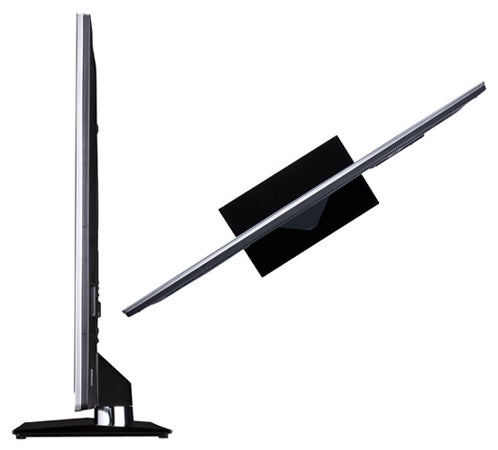
It’s customary now for us to comment on a TV’s potential as a gaming screen, and here again the 46LE831E comes up trumps. Using the provided Game mode and with noise reduction turned off (something the Game mode doesn’t do automatically for some reason), we measured input lag at a reasonable-to-good 39ms – not enough, in other words, to allow you to blame the TV for any epic gaming fails!
Aside from the relatively small niggles already covered, the only negative things we can say about the 46LE831E’s pictures are that many of its image presets are unhelpful; that you thus need to play with the set’s picture features rather regularly to keep it looking its best; that skin tones can sometimes look slightly ripe; and that yellow tones can occasionally look slightly dominant, as in the sequence where Bond fights a couple of assailants in a stairwell in Casino Royale.
There are operational issues too. We’ve touched on the rather cramped, cluttered onscreen menus. But also the electronic programme guide isn’t great, partly on account of the overwhelming amount of information it shows at once and partly because it’s rather slow to load and doesn’t allow you to watch a small version of the TV picture while you explore the listings.
It also took an eternity for the channels to scan when we first set the TV up, but we guess this isn’t a big deal since you’ll probably never rerun the process.
Finishing with the 46LE831E’s sound, here again there’s a considerable improvement over Sharp TVs of the past. According to the spec sheet there’s a subwoofer inside the TV as well as the normal stereo speakers, and while this doesn’t allow the set to sound as potent as Philips’ similarly specified TVs, it does mean there’s slightly more richness and mid-range clarity to sound than we usually hear with flat TVs.
Verdict
Sharp has struggled recently to make a big impact on the UK TV scene, but the 46LE831E really deserves to change this. It’s a bit clumsy in places, and its online features need expanding. But when push comes to shove it delivers some of the best 2D and especially 3D pictures we’ve ever seen at a price that’s much more reasonable than expected.
How we test televisions
We test every TV we review thoroughly over an extended period of time. We use industry standard tests to compare features properly. We’ll always tell you what we find. We never, ever, accept money to review a product.
Trusted Score
Score in detail
-
Features 8
-
3D Quality 10
-
Value 9
-
Design 9
-
2D Quality 9
-
Sound Quality 8
Features
| Size (Inch) | 46in |
| Display Type | LED |
| Max. Resolution | 1920 x 1080 |
| Full HD 1080p | Yes |
| Digital Tuner | Yes |
| Freeview HD | Yes |
| Freesat HD | No |
| 3D Ready | Yes |
| Contrast Ratio | ‘Mega’ apparently |
| Refresh Rate (Hertz) | 200 (100 plus scanning backlight)Hz |
Connectivity
| HDMI | 4 (v1.4) |
| Component | 1 |
| Composite | 1 |
| Scart | 1 (RGB) |
| Digital Audio Out | 1 (optical) |
| Headphone | 1 |
| Charging/Computer Connection | 3 |
| Ethernet | 1 |
| WiFi | Yes, via supplied dongle |
Physical Specifications
| Height (Millimeter) | 663mm |
| Width (Millimeter) | 1072mm |
| Depth (Millimeter) | 34mm |
| Weight (Gram) | 23kg |

